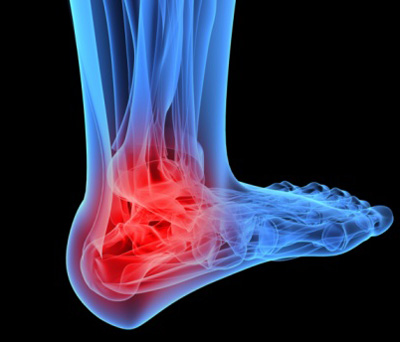
Your alarm clock goes off and it’s morning – time to get out of bed. But you know as soon as you start walking, the heel pain will start. Most likely your pain is a result of plantar fasciitis – the most common cause of pain on the bottom of the heel.
Washington University podiatrist, Michael Weiss, DPM, FACFAS, explains, “The plantar fascia is a long, thin ligament that lies directly beneath the skin on the bottom of your foot. It connects the heel to the front of your foot, and supports the arch of your foot. The plantar fascia is designed to absorb the pounding our feet take every day.
Plantar fasciitis occurs when this strong band of tissue becomes damaged. The body’s response to injury is inflammation, which results in heel pain and stiffness.”
Risk factors
Plantar fasciitis can develop without a specific reason. However, there are several factors that could put someone at risk for this painful condition:
- Very high arch
- Tighter calf muscles that make it difficult to flex foot and bring toes up toward shin
- Obesity
- New or increased activity
Common symptoms
- Pain on the bottom of the foot near the heel
- Pain with the first few steps after getting out of bed in the morning or after a long period of sitting — the pain subsides after a few minutes of walking
- Pain after, but not during, exercise or activity
According to Dr. Weiss, “More than 90% of patients with plantar fasciitis will improve within 10 months of beginning a nonsurgical treatment program.”
Nonsurgical treatment
Dr. Weiss says, “The most important nonsurgical treatment is teaching the patient to control foot mechanics that put strain on these tissues.”
Other treatments include:
- Rest – Reduce or eliminate the activities that make the pain worse.
- Ice – Freeze a bottle of water. Roll your foot over the frozen bottle for 20 minutes – three or four times a day.
- Nonsteroidal anti-inflammatory medication – Ibuprofen (Advil® and Motrin®) or naproxen (Aleve®) can be taken to reduce pain and inflammation under a doctor’s supervision.
- Exercise – Stretching your calves and plantar fascia is an effective way to relieve the pain caused by tight muscles. Your doctor or physical therapist can recommend the correct exercises.
- Cortisone injections – Steroid medication injected into plantar fascia can help reduce inflammation and pain.
- Supportive shoes and orthotics – A cushioned shoe or heel insert can help eliminate the tension placed on the fascia.
- Night splints – While not for everyone, a night splint can be somewhat helpful because it stretches the plantar fascia while a person sleeps. The splint only needs to be worn until the pain is gone – sometimes in just a few weeks.
- Physical therapy – A doctor-recommended physical therapist can help you with an exercise program that focuses on stretching calf muscles and plantar fascia.
Surgical treatment
Dr. Weiss explains, “Surgery is considered only after six months of nonsurgical treatment. The most common problem after surgery is no relief or only limited relief. This is why we try to exhaust all nonsurgical measures before we recommend surgical intervention.”
If you have chronic foot pain, please call to make an appointment with Dr. Weiss. Patients are seen at:
Barnes-Jewish West County Hospital Campus
969 N. Mason Road, Suite 140
314-747-4769
Barnes-Jewish Center for Outpatient Health
4901 Forest Park Avenue, Suite 340 AND Suite 420
314-362-1300
The topic of this article was requested by a Your Health Update reader. Do you have a medical topic you would like one of our 1,300 specialists to address? Please send your question to WU.Physicians@wustl.edu.